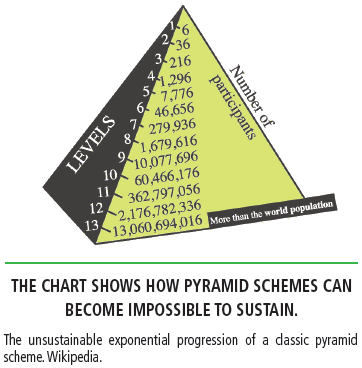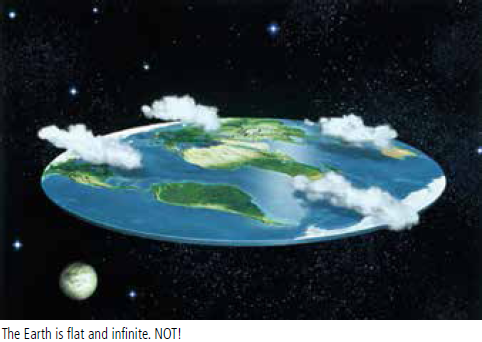The Population and Immigration Ponzi Scheme
Published on May 6th, 2014
PDF Download: ponzi_pweb_b_may_2014.pdf
 Carlo Pietro Giovanni Guglielmo Tebaldo Ponzi (1882-1949) was an Italian immigrant to America better known as Charles Ponzi. Of course he was the swindler who in the early 1920s bilked his clients out of $20 million—worth more than $240 million in 2014 dollars.
Carlo Pietro Giovanni Guglielmo Tebaldo Ponzi (1882-1949) was an Italian immigrant to America better known as Charles Ponzi. Of course he was the swindler who in the early 1920s bilked his clients out of $20 million—worth more than $240 million in 2014 dollars.
Ponzi attracted incautious investors to his getrich- quick ploy by offering implausibly high rates of return: an incredible 50% profit in 45 days. He funded this pyramid scheme by paying earlier
investors with the investments of later investors, also known as robbing Peter to pay Paul. It “worked” at least until the inevitable bursting bubble and prison term.
At least Ponzi left behind his name as an object lesson of something that prudent persons and societies should avoid: Ponzi or pyramid schemes that depend upon perpetual, exponential growth in the number of participants and that are therefore certain to collapse sooner or later.
The problem is that we humans would rather not learn that lesson, which was why the execrable Bernie Madoff was able to get away with his even larger Ponzi scheme for so many years.
It’s easier to dupe ourselves, to continue believing in fantasies and delusions of grandeur: in something for nothing, in having our cake and eating it too, in perpetual motion machines, and in things that are just too good to be true.
One such fantasy is infinite growth on a finite planet.
Joseph Chamie, a former director of the United Nations Population Division, recognizes this when he refers to “Ponzi Demography.” As Chamie puts it:
While it may come in many guises, Ponzi demography is essentially a pyramid scheme that attempts to make more money for some by adding on more and more people through population growth.
While more visible in industrialized economies, particularly in Australia, Canada and the United States, Ponzi demography also operates in developing countries. The underlying strategy of Ponzi demography is to privatize the profits and socialize the costs incurred from increased population growth.
 Population growth—from births, immigration, or in America’s case, both—results in higher demands for goods and services, more material consumption, more lending and borrowing, credit and debt, and of course higher profits. For awhile. But while this combination lasts, its effects are intoxicating. Politicians, power brokers and economists are drunk on it, but we’re all imbibing. Those who caution against it, who warn of irrational exuberance, or limits to growth, seem like shrill teetotalers and killjoys. Party poopers.
Population growth—from births, immigration, or in America’s case, both—results in higher demands for goods and services, more material consumption, more lending and borrowing, credit and debt, and of course higher profits. For awhile. But while this combination lasts, its effects are intoxicating. Politicians, power brokers and economists are drunk on it, but we’re all imbibing. Those who caution against it, who warn of irrational exuberance, or limits to growth, seem like shrill teetotalers and killjoys. Party poopers.
If we lived in a world of unlimited resources—a Flat Earth with boundless resources expanding infinitely in all directions—unlimited population growth might not be a problem. But here’s a news flash: the Earth is not flat and infinite, but round, bounded and finite. It is a sphere, not a boundless plane.
Its natural capital—land and open space, water, air, atmosphere, forests, fertile soils, fisheries, fossil fuels, minerals—is fixed. But these capital stocks are not constant; rather, they are all deteriorating from the ever-increasing demands of Ponzi demography and Ponzi economics.
In the United States and around the world, we see the shocking deterioration and decay of natural resources. Today’s 7.2 billion humans are busy fouling our one and only nurturing nest in a vast and forbidding cosmos. The oceans are turning acidic, and the water, air and soil, toxic. The atmosphere, climate and weather are becoming volatile, unruly and unpredictable. A rising sea level is starting to swallow up low-lying coastal cities and even a couple of small island countries. Fish stocks are shrinking or collapsing, and fishermen are netting and hooking stunted runts instead of the gaping giants of yore.
 Forests are succumbing to fires, insects, disease and chain saws. Man-made deserts are on the march, and crops are shriveling from heat stress and insufficient moisture. Oil supplies and high-grade metal ores are being exhausted. Wildlife is vanishing and biodiversity unraveling.
Forests are succumbing to fires, insects, disease and chain saws. Man-made deserts are on the march, and crops are shriveling from heat stress and insufficient moisture. Oil supplies and high-grade metal ores are being exhausted. Wildlife is vanishing and biodiversity unraveling.
But against all recent scientific evidence, the devotees of Ponzi demography fantasize that the future geniuses, creators, innovators, producers and workers found among the 80 million more people added to the world population every year will come to the rescue. Far from crushing the world, the cornucopians argue, an everlarger human population will transform the Earth into an ever cozier, more accommodating habitat. Flourishing megacities and gigacities will dominate Planet Earth.
This is magical thinking on a colossal scale—ecologically uninformed and scientifically absurd. Like its financial counterpart, Ponzi demography and economics are faith-based and factually deficient.
Chamie points out that the demographic Ponzi schemers exploit fears of becoming an aging society with a population (and national vitality) in decline, decrepit and stooped, with our best years behind us. Without a young, growing and vigorous population, without enough cannon fodder for our military, we face a bleak future of financial ruin and loss of national power and nerve. Social Security and Medicare will become insolvent, undermining the well-being of senior citizens and threatening the economy with stagnation.
Therefore, we must boost birth rates. It is our patriotic duty to bear more children on behalf of the homeland. One such appeal goes: “Have one [child] for mom, one for dad and one for the country.”
We must also welcome more immigrants. Chamie again:
… Ponzi demography also turns to immigration for additional population growth in order to boost companies’ profits. The standard slogan in this instance is ‘the country urgently needs increased immigration,’ even when immigration may already be at record levels and unemployment rates are high. [Sound familiar?]
Among other things, increased immigration, it is declared, is a matter of national security, longterm prosperity and international competitiveness. Without this needed immigration, Ponzi demography warns that the country’s future is at serious risk.
 In the United States, the Chamber of Commerce, the National Association of Manufacturers, Microsoft, and billionaires Bill Gates, George Soros and kid wonder Mark Zuckerberg, among many other hip tycoons, spend staggering amounts of money trying to convince Congress to open the immigration floodgates further. Even the highest immigration rates in our history for the last 30 years are not enough to satisfy their gigantic greed and hubris. These rich titans of industry and finance are fawned over by an intellectually complacent, politically correct mainstream media that has swallowed, hook, line and sinker, the propaganda that it is small-minded, if not downright racist and xenophobic, to advocate restricting immigration.
In the United States, the Chamber of Commerce, the National Association of Manufacturers, Microsoft, and billionaires Bill Gates, George Soros and kid wonder Mark Zuckerberg, among many other hip tycoons, spend staggering amounts of money trying to convince Congress to open the immigration floodgates further. Even the highest immigration rates in our history for the last 30 years are not enough to satisfy their gigantic greed and hubris. These rich titans of industry and finance are fawned over by an intellectually complacent, politically correct mainstream media that has swallowed, hook, line and sinker, the propaganda that it is small-minded, if not downright racist and xenophobic, to advocate restricting immigration.
It is truly a wonder that scrappy groups like CAPS have managed to hold off another “shamnesty” and “comprehensive immigration reform” for as long as we have.
The infantile “bigger is better” mindset is entirely appropriate for 5-year-olds who still need to add both weight and height to fulfill their human destiny and lead a happy life. But it’s senseless for a mature 30-year-old to seek to continue growing physically, as opposed to mentally, ethically, and in experience and wisdom. It’s just as senseless and self-destructive in mature human societies to seek growth ad nauseam—the ideology of the cancer cell, as Edward Abbey once quipped.
No Ponzi or pyramid scheme is sustainable in nature. And if we are serious about sustainability, we must bite this bullet. Former U.N. Population Division Director Joseph Chamie could be a spokesman for CAPS when he writes:
The sooner nations reject Ponzi demography and make the needed gradual transition from ever-increasing population growth to population stabilization, the better the prospects for all of humanity and other life on this planet.
Amen to that, brother.
Leon Kolankiewicz is a CAPS Senior Writing Fellow,environmental scientist and planner.




